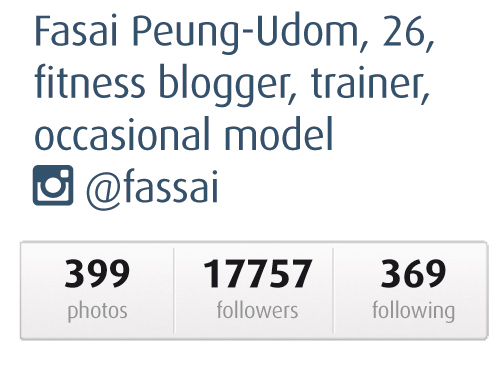Advertisement
Advertisement
How did you become a photographer and move into filmmaking?
I studied architecture at Thammasat but decided right after graduating that it wasn’t what I wanted to do. It started out as countless unpaid experimental projects, helping friends take photos at parties. I didn’t even have my own camera at first; I had to borrow one from a friend. My first camera was a compact. I got a job with Art Asava as a Fashion Merchandiser. Then through connections I got to meet Gene Kasidit and work on the cinematography for his “Gep Kam Wa Rak (ONS)” music video. I only started filmmaking a year and a half ago.
How do you explain your success so far?
I know what I want to show my audience and how to play on their emotions. I already have the pictures in my head before I take the photos. Looking through the lens is just a way to frame them. I give everything my best shot. There was one commercial where I had to film using a crane, which I’d never done before. It felt awkward but I didn’t give up until it worked. Boundaries are nothing, you just need to keep pushing yourself.
What do you make of claims that anyone can be a good photographer right now with the latest photo editing apps?
It’s not about good filters or expensive cameras. It’s the individual behind the camera that counts. Creative work in Thailand looks mostly the same because everyone copies one another when they see something they like. I don’t copy. When I see something that inspires me, I might look at the techniques used and ask myself how I can develop it into my own style and still communicate as me.
Any tips about working in the creative industry?
Kids these days want to be something that’s in-trend. They want to be this and that, but they end up nowhere because they forget to be themselves first. Freedom to be yourself is expensive, so keep it. I don’t bother about being anyone else. I’m not a funny person, so I don’t try to crack jokes. I rarely party; either I study, work or hang out with friends. Some things in society are overrated.
What’s your biggest dream?
I don’t have dreams. I have passion. It’s what drives me and I put it into my work. It doesn’t matter what career you’re in, as long as you do it with love and faith, you will never go hungry.
What’s next for you?
I like doing a lot of projects at the same time. For me, doing just one thing is boring. I just flew to New York for work and got to expand my portfolio. The art scene there is more open-minded and vibrant than in Thailand, so I’m planning to take on more international projects. I also just started working on a big top secret project here, which will start shooting soon.
Advertisement
Why the name 3-2-1?
Gavin: It’s easy and catchy for Thais and foreigners to pronounce. It was actually the idea of the creative team. But we did try. We came up with stuff like “Bubble Pop” and “Coco-Pop.”
Poppy: 3-2-1 is like a countdown. We’re unique because we have only one girl. I get to be the most beautiful group member. I wasn’t even their first choice; the guys wanted a sexier girl.
How do you guys get along?
Gavin: In the beginning we didn’t talk to each other at all. We didn’t get along. Then one day we were like, hey, shouldn’t we get to know each other? Now we spend more than 12 hours a day together, we’re like a family.
Describe your sound.
T.J.: We represent T-Hop style (Thai-pop mixed with hip-hop). A lot of Thai musicians do one or the other but don’t combine both.
Who are your biggest fans?
T.J. My parents, especially my mom. When our first album wasn’t going well, she told me that I could still succeed. Then Boom. “Nan-Oak” comes out and bam! We’re big! Poppy’s parents are also supportive and go to see her at every concert.
Gavin: My parents are more like auditors, they never get directly involved. But they manage to find out everything anyway. They have their connections, talking to everyone from the guards, the PR team, the producers and the assistants.
What’s the best feedback you’ve got for “Rak-Tong-Perd?”
Poppy: I love the covers of the song on YouTube,. And people recognize me more, but they call me “Nong-Nan-Oak” because of the song. It’s ok because at least they remember me now.
How do you feel when people say the song is only a success because of Baitoey?
Gavin: We get that a lot. But if we didn’t have the song, the choreographers, 3-2-1 or Baitoey, then the song wouldn’t have happened. It’s about all these people coming together and making it such a great song.
How do your fans perceive you?
T.J.: Gavin is definitely a favorite with the girls. Clearly, I’m the scariest as fans won’t take pictures with me—maybe because of my tattoos and mustache. But, I’m happy to get the badass image.
What’s next?
T.J.: We haven’t planned anything yet. C’mon, we’ve only just released “Nan-Oak” and the feedback was a real shock. But we definitely want to go global. We want everyone to listen to our music.
Advertisement
 What do you mostly post?
What do you mostly post?My activities and selfies. Instagram is like a relaxing place where I love to share good stuff with people. Posting my six-pack shows that I love my healthy lifestyle without having to explain it in words.
Why are you so popular?
There’s no one reason. My number of followers grew gradually over many months as my friends tagged me in their photos. It’s called viral feeding. They might love my lifestyle. I’m a landscape photographer, so I always post beautiful places and fun activities.
Do you have any stalkers or annoying followers?
I occasionally get some psycho followers who leave dirty comments like, “What’s the size of your dick?” I delete them all. My parents are also on Instagram and follow me. I don’t want them to see those kind of things.
Are you addicted?
I think so. I post about 3-4 pictures a day. I have so many pictures from my work that I simply feel the need to post.
What are the benefits?
I’ve gotten jobs from followers. It’s also great to know I have friends in other countries, as many of my followers live abroad. I’ve been recognized walking around Taipei and Singapre, where I got taken to pubs and restaurants that only locals know! It’s cool. Instagram also brought me back in contact with friends from kindergarten, too!
See his Instagram feed here.
 Why are you so popular?
Why are you so popular?
I think it might be down to the fact that I’ve been tagged by my friends and people come to my account to follow me, too. Lots of my friends are DJs and actors.
Do you have any stalkers?
Not really. My followers are nice. But some annoying people try to use my photos as a way to promote their shops or products. Also, some foreigners leave comments like “you’re ugly.” I delete them all, though. I don’t want any strangers saying stuff like that.
Are you addicted?
Yes. I must post at least 1-2 photos a day and I check it every 10 minutes if I don’t have anything to do. I know that it’s not good. Sometimes it means I don’t really interact with the people around me or spend my time on more worthwhile things.
What are the benefits?
I’ve had some modeling jobs before, but Instagram definitely helps me get my name out there. I’ve gotten small roles in lakorn or sitcoms through it. Agencies have also contacted me to advertise their products, such as facial creams and supplements. As I have 30,000-plus followers, I charge B7,000-B10,000 depending on the product.
See her Instagram feed here.
 What do you mostly post?
What do you mostly post?
It’s mostly to do with my job as an MC as well as personal activities like hanging out with friends. Many people have the wrong perception about my line of work thinking that we’re all mistresses of rich men. But showing my lifestyle is a way to tell people the truth about what we do. We are just as serious about our job as those who work in offices. I also share beauty and fashion tips with my fans, too. Some of my pics might be sexy but it’s basically just my portfolio showing that I do various jobs.
Do you have any stalkers?
I normally delete any dirty comments. The most disgusting one was probably a guy who said he wanted to have sex with me. But, honestly, dirty comments are really rare. I normally get good feedback from fans. Sometimes it’s a mid-40s office woman who remembered me from when I worked at the motor show. Sometimes it’s a foreigner who tries to impress me by commenting in Thai with words they’ve got from Google Translate. Those make me laugh.
Are you addicted?
Yes. I post 2-4 pictures a day and constantly check my account. It’s pretty annoying for the people around me.
What are the benefits?
Instagram is like my work portfolio with my lifestyle thrown in. I don’t even have to cast for a job these days. I get money from people who want to sell their products on my Instagram. I charge B4,000-B5,000 per picture. But I don’t take all the offers that come my way because I want the focus to be on my lifestyle and getting people to know me more.
See her Instagram feed here.
 When did you start Instagramming?
When did you start Instagramming?
Just six months ago. I wasn’t a part of Thailand’s smartphone craze as I just got back from New Zealand where people aren’t so addicted to social media.
What do you mostly post?
I actually started it for my model toy business but I realized that it didn’t work because my target customers weren’t on Instagram. So, I switched to selling another product, my fitness routine which I’ve done for years and which I promote by posting selfies. I also post fitness tips such as how to eat well or how to lose weight.
Why are you so popular?
It started when I was doing some modeling and the people started tagging the pics with my Instagram account. I think that when people visited my profile, they noticed that my posts provide useful tips for staying fit and healthy—so they decided to follow me. I mainly use Thai and most of my followers are Thai.
Do you have any stalkers or annoying followers?
Nope. There’s only been the case of an online business stealing my photos to promote their products. But I couldn’t be bothered by that. I do sometimes bump into my followers on the street, though, so I have to make sure I dress well before going out!
Are you addicted?
Totally. I post 2-3 photos a day and constantly plan my posts in advance. I want people to remember me whenever they think about fitness. I see it as my job, so it’s a healthy obsession.
What are the benefits?
It’s good for my credibility, for sure. People are more likely to believe in what I say. It also pushes me to do better. There are many talented people out there, so I need to work hard to stay ahead.
See his Instagram feed here.
 Why are you so popular?
Why are you so popular?
I think it’s because of all the [South Koren entertainer] G-Dragon fans—I’m one too! I did my hairdo like his and it seems one of the GD fans spotted me. After that, my followers list grew very fast, at almost 2,000 new followers a day. But now it’s pretty steady.
Do you have any stalkers?
I do. I had no choice but to block some people who repeatedly commented on all my pictures. Often these are gay haters, mostly men. They leave rude comments after seeing my pictures on Instagram’s “explore” popular page. I have to delete them all the time. My girlfriend is also harassed by some of my followers. They’re just jealous of her.
Are you addicted?
Absolutely, but I’m trying to slow down a bit now. It’s really unhealthy. I used to think about posting photos all the time. It left me no time to just be with myself. I’m too tired to follow others.
What are the benefits?
I’ve now got lots of foreign friends, especially in Asia. I’ve made connections for when I want to travel to places like Indonesia or Vietnam. Some people contact me for advice as their country doesn’t accept gay relationships. Some companies contacted me to sell their products on my Instagram account but I turned most of them down. I don’t want to mess up my posts. I already sell products such as shirts, facial cream and supplement ary milk, so I don't want to confuse my followers about where stand.
See her Instagram feed here.

 Why are you so popular?
Why are you so popular?
Gun: We already had lots of followers, but it’s grown really fast as more girls discover we are a gay couple. We call this kind of fan “Y-Girl.” They love to see guys in love with each other. It’s been a trend for a while; they love to imagine their beloved good-looking male singer in love with another guy who is his close friend. They follow us because we are a real-life couple. Also some celebrities like Ploy Chermal have posted our pictures on their accounts—that got us at least 40,000 followers.
Do you have any stalkers?
Gun: As our pictures always pop up on Instagram’s “explore” page, there are many foreigners who leave rude comments like “Fuck Gays,” “Fuck your mother,” or “Shit”—our fans fight back, too, though.
Are you addicted?
Theo: Kind of, but I don’t think it’s too much. We just post photos when we go out to work or to cool places, or if we just want to say hi to our fans. At most, it’s about 3-4 photos a day. Some days we don’t post anything.
Gun: I don’t think I’m addicted. It’s normal to post photos on social networks.
What are the benefits?
Theo: Fans! We get more people who love us and care about us. Our fans range from teenagers to 50-year-old aunties. Of course, we also get more jobs out of it. We’ve been hired to go out and post about events and products. We also have two movie projects coming out. One is due in June, TomGay: Muen Rak Salub Kua, and another, Boy Story, might be out in July.
Advertisement
 Has it been emotionally difficult putting on this exhibition?
Has it been emotionally difficult putting on this exhibition?
There have been a lot of struggles, particularly when discussing Tim with his parents and close friends. Other obstacles are technical, like getting the photo copyrights, contacting agencies and dealing with the press.
How did you guys know each other?
We met in Wales in 1999. He and I were both professional photographers. We both loved to travel and shared a common vision to show a sense of humanity that moves past stereotypes. We became close friends.
As a photographer yourself, how would you describe the impact of these photos?
It allows us to see the humanity that exists behind these soldiers, what happens in the daily lives of these 19 to 25-year-old young men who are asked to fight for their country.
Thankfully, most people never have to experience firsthand the ravages of war; how is the exhibition relatable to Thai audiences?
You don’t even have to be interested in war stories or politics to go see it. Every nation has soldiers but most don’t know what goes on in these men’s lives. It’s not all about a bunch of guys shooting bullets at people. Things can be quite unexpected—how their lives are just like any normal young men, how they become good friends and learn to live with each other. I think this can be applied to the Thai soldiers fighting in the South right now.
It’s been mentioned that the exhibition reveals humor in the warzone; can you elaborate on that?
During the time Hetherington spent with the platoon, his photographs capture the domestic lives of the soldiers. It’s similar to how you would hang out with your friends: they played Guitar Hero, wrestled, showed off their new tattoos, just had fun the way guys do, except that it was in the middle of a warzone.
What message do you want audiences to taken from it?
I want them to look at war in a fresh way; to think and interpret things differently. This is a universal goal that photographers all around the world want to accomplish.
What exactly can we expect from the exhibition?
The exhibition shows photographs published in the book Infidel, as well as two films. The photos were taken by Tim Hetherington in Afghanistan and mainly feature the lives of the soldiers in the valley, a slice of their personal lives and the inhumanity of war. The videos, called Diary and Sleeping Soldiers, are definitely worth seeing. The films give an insight into Hetherington’s personal experiences and work during his ten years of conflict reporting.
After the exhibition in Thailand, where will you be showcasing it next?
We’ve done the show in London and Washington DC, and Thailand is our first stop in Asia. We haven’t got concrete plans on where we will go next.
Advertisement